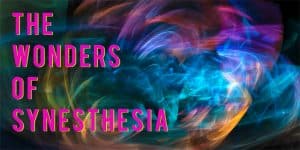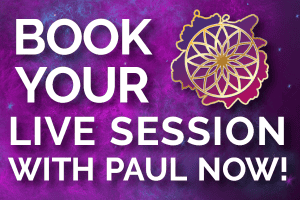
The Mind Is Complex! A Shutterstock licensed image.
At first glance, “Synesthesia” appears to be a melodic word, promising something of an adventure. In many ways, this idea holds true. If scientific innovations for the brain, like neurofeedback and ACT, have shown us anything, it’s that there’s so much we still don’t fully understand.
Synesthesia is a unique neurological event that occurs when a combination of our 5 senses intermingle and produce fascinating results. People with synesthesia might taste words or see colors when they hear music. The wonders of this neurological phenomenon certainly point to the complexities of the human mind and sensory systems.
For some, these are the types of things that happen when taking acid or tripping on mushrooms. You might have this experience when ingesting pure MDMA. Meanwhile, some of the more spiritually devout folks out there might have Synesthesic experiences during meditation or an overwhelming spiritual activity, like being hugged by Amma, The Hugging Saint.
We can learn wonderful things about ourselves from Synesthesia. For science, this is relatively uncharted territory, but it’s gaining recognition and popularity. Since many people might never have been able to connect the dots about their condition, they might never realize that are having Synesthetic experiences.
What Does It Mean To Have Synesthesia?
The word “synesthesia” comes from the Greek word: “synthes.” The Greek translation of the word means unity. Specific senses or stimuli most often trigger Synesthetic experiences. This usually revolves around things related to or involving sound, smell, color, shapes, and touch.
The most common form of synesthesia is called grapheme. Grapheme-color Synesthesia occurs when individual letters or numbers trigger an automatic association with a particular color.
Here’s an example for easier understanding: when I type my name on my keyboard, I automatically associate each letter with its corresponding color:
P = red, A = blue, U = green, and L = yellow
Synesthesia always has a core commonality which they all share. The common shared point is that synesthesia fuses two different sensory perceptions together that are not experienced by the majority of all other people. This is what makes each Synesthesia event so unique and fascinating.
These are seriously wonderful!
Synesthesia is not caused by any disease and it does not harm the nervous system in any way. It’s part of the chemical and neural-magic that’s built into humanity and the experience of being human.
What’s Unique About The People Who Experience Synesthesia?
Synesthesia is a rare condition, and even more perplexing is that those who have it often do not know how or when they began to experience it. People who experience synesthetic perceptions often report they’ve had these sensations their whole lives. Many are more intrigued than bothered by it. Some feel it’s a super-hero skill.
Interestingly, some professional musicians speak of having the condition because they report they “see” music in color. Or they taste textures like round or pointy. 2%–4% of the population have Synesthesia, yet most of us don’t know anything about it.
There is one thing that is both specific and varied amongst those with synesthesia: whatever color is evoked remains pretty constant over time within the person’s lifetime. Yet, the color evoked changes and varies from person-to-person depending on their backgrounds or interests.
Synesthesia has been associated with various conceptual and perceptual benefits, suggesting that the genes involved may be selected for their hidden agenda. But no one can agree on the hidden agenda or why it needs to have a clear-cut agenda at all.
Do Animals Experience Synesthesia?
Researchers have found evidence that chimps, like humans, experience some form of Synesthesia. Synesthesia was found in some primates who experience a rare condition known as “synthetic color.” Primates were able to see different colors for letters or numbers than other objects.
We already know the human brain has an incredible ability to negotiate between all our senses when we are sight-impaired. For example, many people associate certain musical notes with specific sounds, such as high Cs sounding like PPP! Yet others taste shapes, and still others hear drawings coming out of their mouths when singing.
Are You a Synesthete?
Have you ever wondered if some of your senses may be overlapping? For example, Synesthetes have unique experiences whereby certain colors, numbers, and letters seem to have an emotional significance. Those who experience this phenomenon will often take part in Synesthesia tests that help provide clarity for their life journeys.
A Synesthesia experience gives some people insights into ranges and depths of what they subjectively perceive through different parts of their brains. Of course, Synesthesia tests have their pros and cons, so don’t take them as 100% accurate diagnostics. Rather, see them as learning tools involving others who experience sounds as colors or shapes. When taking these tests, you might discover what it feels like to experience these sensations.
Several tests can help people with this neurological condition find clarity in their perceptions. Scientists and researchers say that Synesthete tests provide some of the most reliable ways through which we can explore our minds, learn new things, or even wrap our minds around the meanings of our perceptions.
It is only through understanding of how they relate back together and related to other aspects that can gain value from them. While the testing tools aren’t perfect, they always yield fascinating results.
How Does The Test Work?
An example of a test is as follows:
-
-
- Pick colors from letters of various sizes, numbers on coins, or days off work
- If you can correctly identify what these items look like, you may have some type of ‘Synesthesia.’
-
The next aspect that’s tested is reaction time. You’ll be asked whether or not your color matches any given letter before it’s revealed. If you can complete both tasks quickly without making errors at either the reaction or selection stage – you’ve passed!
The Wondrous World of Living With Synesthesia
The composer Olivier Messiaen, speaking of the union between color and tone in his music, explained to an interviewer: “When I hear music, it is not imagination nor psychic phenomenon. It’s within myself.”
Imagine you were able to meld or blend one sense until it becomes mixed with another? You might wonder if you are able to perceive visually through hearing colors while hearing palate tastes audibly. If every time you touched a texture, and heard a sound that resonated through your body, how much more creative could you be?
If you have this unique condition in which the stimulation of one sense causes you to experience another simultaneous sensation, imagine how different everything in your life would be. There’s a growing body of evidence supporting the idea that Synesthesia is more than just an imaginative or creative use of metaphors.
Amid a Synesthesia event, it seems the boundaries between the senses to bend or break down. Apparently, our senses exist within us but also go beyond what we typically think about as our physical containment and existence.
What Worlds Would You Want to Open if You Could Have Synesthesia for a Day?
The variety of colors and shapes in the world are more beautiful than we might be able to communicate. What if you were given a chance to experience a whole other level of the rich perception of color, shapes, and sounds? Wouldn’t it inspire an inner peace and feeling of supernatural beauty? Every plastic cup can hold sparkling ice with lemon-colored sounds covered with sugar that emits a sigh that only you hear. The possibilities are endless!
The month of December can make most of us shiver and think of decaying branches and hard-packed snow. Imagine, if instead of feeling cold when you read the word December, you see the word in beautiful, lush blue? Try to wonder if instead of shivering in forlorn thoughts, you hear music that lights up your heart and soul with wonderful memories.
Try to Live Your Life Every Day By Opening Up Your Senses to Possibilities
Colors have always danced with sounds, even if you have never noticed them before. You can often listen to music, and if you turn it loud enough, you will register the vibrations. If you try to live your life every day by taking flight into another realm where time stops but eternity lives, what could or would you find?
There’s no right or wrong answer. There are just possibilities. What’s even better is that they are your possibilities because it is your life, your memories, and with only your essence that gives you power every day. Use that power to experience the wonders of opening doors by experiencing some of our unknowns, like synesthesia.
All of us should experience things we’ve never thought we would try. If we don’t try, we may never know what could have been.



